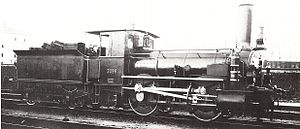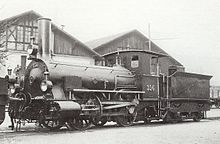NOB C 2/2 (Maffei)
| C 2/2 (conversion to D 2/2) | |
|---|---|
| Numbering: | NOB 40-45 SBB 3094-3099 |
| Number: | 6th |
| Manufacturer: | Maffei |
| Year of construction (s): | 1864 |
| Axis formula : | B. |
| Gauge : | 1435 mm ( standard gauge ) |
| Length over buffers: | 12,410 mm |
| Fixed wheelbase: | 2,438 mm |
| Service mass with tender: | 40.7 t (44.5 t conversion) |
| Friction mass: | 21.9 t (24.5 t conversion) |
| Driving wheel diameter: | 1,676 mm (1,390 mm conversion) |
| Control type : | inside |
| Number of cylinders: | 2 |
| Cylinder diameter: | 381 mm |
| Piston stroke: | 609 mm |
| Boiler overpressure: | 10 bar |
| Number of heating pipes: | 171 (164 remodeling) |
| Heating pipe length: | 3,500 mm (3,420 mm conversion) |
| Grate area: | 1.10 m² |
| Radiant heating surface: | 6.70 m³ (6.10 m³ conversion) |
| Evaporation heating surface: | 87.60 m² (93.10 m² conversion) |
| Water supply: | 8.3 m³ (9.0 m³ conversion) |
| Fuel supply: | 2.5 t coal (3.0 t conversion) |
| Train brake: | from 1887–89 Grinder brake from 1893 Westinghouse |
| Speedometer: | 55 km / h conversion |
| Control: | Gooch |
The six steam locomotives of the type C 2/2 of the Swiss Northeast Railway ( NOB ), were manufactured by Maffei in Munich in 1864 .
These machines were procured by the NOB for the Zurich – Zug – Lucerne Railway , which was operated by the Swiss Northeast Railway. In 1892, the NOB finally took over the Zurich – Zug – Lucerne – Railway. For this reason, the locomotives were included in the NOB numbering scheme.
Technical
As a result of the construction problem with the D 2/2 and the resulting reduced maximum speed of this locomotive, 6 steam locomotives were delivered for passenger train service by the Maffei locomotive factory in Munich in 1864. It was a two-axle, 22-tonne locomotive with a two-axle tender. The wheelbase of the machines was 2440 mm. Both axes were located in front of the fire box , also because of the controls mounted between the outer frame. This resulted in a rather large rear overhang, which is why the top speed had to be limited to 55 km / h due to the design. This means that these machines did not reach the desired speed of 65 km / h, according to which they were classified anyway.
The boiler was 1730 mm above the top of the rail. The first boiler was made of cast steel sheet, the fire box was made of copper. The replacement boiler was a Maey type. The drive mechanism was arranged outside the frame, the drive cranks required for this were designed as long-necked cranks according to Hall's shortened design. The control was arranged in the Gooch type within the frame, which was a rarity for steam locomotives in Switzerland. This resulted in a not exactly advantageous long vapor path. The slide pushrod also had to be arched around the front axle. There were two sandboxes on the rotating sheet. The suspension springs stood above the frame, the front supports of the springs on the front axle were connected to one another with an angle lever and tie rod below the bumper.
The spindle brake only worked on the tender axles and was designed in eight blocks. The tender had an outer frame and the suspension springs were above the axles on the outside of the frame. A grinder brake was installed around 1887–89. It was replaced in 1893 by one of the Westinghouse Brermse which, like its predecessor, only worked on the tender.
Conversion in D 2/2
Because of the reduction in the maximum speed, the diameter of the driving wheel was too large for the 12 per thousand gradients in relation to the machine output. That is why the locomotives were rebuilt in the NOB workshop in Zurich.
During the renovation, the 1676 mm wheels were replaced by wheels with a diameter of 1390 mm. At the same time, the boiler was replaced with one with a Maey type fire box. Various changes were also made to the suspension springs, revolving sheet metal, wheel arches and driver's cab. The conversion costs for each machine are given as 35,500 Swiss francs. The conversion was a success, because afterwards it was considered an economical machine.
Number table
| NOB until 1879 |
NOB 1879-1895 |
NOB 1895-1902 |
SBB from 1902 |
Surname | Factory number |
Construction year | Manufacturer | Reconstruction of the 2nd boiler |
Discarded |
|---|---|---|---|---|---|---|---|---|---|
| 40 | 111 | 355 | 3094 | Lucerne | 474 | 1864 | Maffei | 1883 | 1906 |
| 41 | 112 | 356 | 3095 | train | 475 | 1864 | Maffei | 1877 | 1905 |
| 42 | 113 | 357 | 3096 | Altorf | 476 | 1864 | Maffei | 1877 | 1905 |
| 43 | 114 | 358 | 3097 | Schwyz | 477 | 1864 | Maffei | 1884 | 1906 |
| 44 | 115 | 359 | 3098 | Punch | 478 | 1864 | Maffei | 1879 | 1905 |
| 45 | 116 | 360 | 3099 | Sarnen | 479 | 1864 | Maffei | 1879 | 1906 |
Operational
Until the takeover by the NOB (1892), the locomotives served on the Zurich – Zug – Lucerne line. Even after that they could still be found on their home track. But they earned their bread of grace on the Linth valley route.
At SBB, they were assigned to the main workshop in Zurich and thus to District III.
swell
- Alfred Moser: The steam operation of the Swiss railways 1847-1966 . 4th updated edition, Birkhäuser, Stuttgart 1967. S. 86ff


